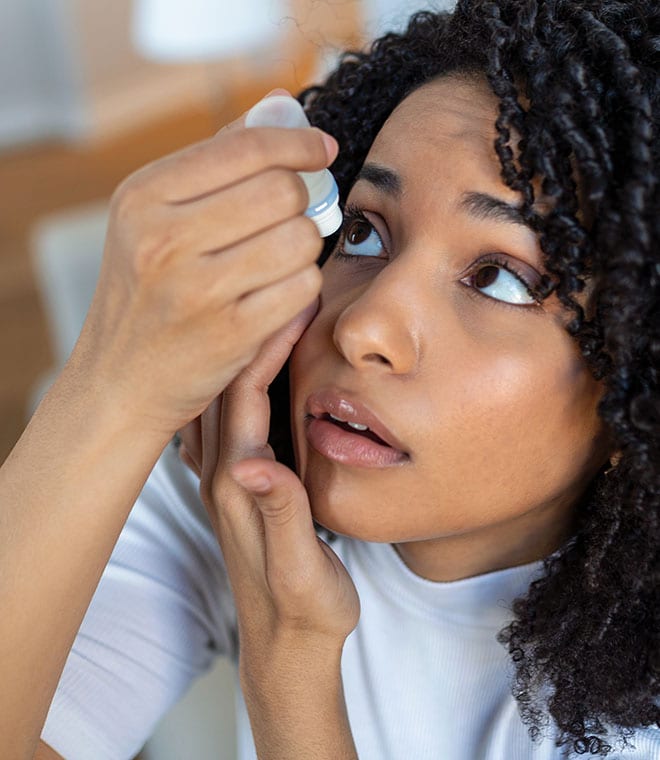
Buying Guides
How to choose an over-the-counter allergy medication
By Sanjay “Jay” Patel, Doctor of Osteopathic Medicine | Allergy & Immunology Jun 11, 2024 • 7 min
If you’re one of the more than 50 million people who suffer from allergies, over-the-counter (OTC) allergy medications may help you manage symptoms. There are different types of OTC allergy medications available, and each comes with benefits and downsides. Be sure to ask your healthcare provider which type of treatment is most appropriate for you.
Nasal corticosteroids
View nasal corticosteroid products
Delivered in the form of a nasal spray, nasal corticosteroids reduce allergy-related inflammation in the nasal passages. You may also see these medications referred to as nasal steroid sprays. Some nasal corticosteroids are available without a prescription, including:
- Budesonide (Rhinocort)
- Fluticasone (ClariSpray, Flonase)
- Triamcinolone (Nasacort)
Benefits and usage
Nasal corticosteroids can effectively relieve a range of symptoms associated with allergies, such as a runny nose, congestion, sneezing, and itchy or watery eyes. They are generally safe to use daily while allergy symptoms persist.
Downsides, side effects and risks
One of the biggest disadvantages of nasal steroid sprays is that they may take a few days to achieve optimum symptom relief. It can also take a little practice to learn to use nasal spray correctly. Healthcare providers typically recommend using them for a few weeks to control allergies.
Nasal steroid sprays may cause nosebleeds in some people. Although rare, they may damage the septum or increase the risk of glaucoma and other side effects. These problems occur most often due to incorrect use.
Although nasal corticosteroids are considered steroids, they don’t carry the high risk of side effects typically associated with steroids. This is because the medication is targeted in the nose, so only small amounts enter the bloodstream.
First-generation oral antihistamines
View first-generation oral antihistamine products
Available over the counter as generic diphenhydramine and under the brand name Benadryl, first-generation oral antihistamines disrupt the effects of histamine.
Benefits and usage
First-generation oral antihistamines can provide temporary relief from all common allergy symptoms, including itching of the nose and throat, sneezing, runny nose, congestion and itchy, watery eyes. They usually work quickly, and they may also help alleviate symptoms of motion sickness.
Downsides, side effects and risks
Although they work quickly, first-generation oral antihistamines only relieve allergy symptoms for a few hours. Most people will need to take them every 4 to 6 hours to control allergy symptoms.
Drowsiness is a common side effect of first-generation oral antihistamines. You may not be able to drive or operate heavy machinery after taking them. Other potential side effects include:
- Constipation
- Dizziness
- Dryness of the mouth, nose and throat
- Headache
- Loss of appetite
- Muscle weakness
- Nausea
- Nervousness
Less often, diphenhydramine may cause vision problems, difficulty urinating or painful urination. People age 65 and older may be at a higher risk for side effects, so healthcare providers may not recommend them for older adults.
Second-generation oral antihistamines
View second-generation oral antihistamine products
Second-generation oral antihistamines are another type of medication available for allergy relief. Like first-generation antihistamines, the medications interfere with histamine. Over-the-counter second-generation oral antihistamines include:
- Cetirizine (Zyrtec)
- Fexofenadine (Allegra)
- Loratadine (Claritin)
- Levocetirizine (Xyzal)
Benefits and usage
Compared to first-generation drugs, second-generation oral antihistamines are less likely to cause drowsiness, but they still relieve a variety of allergy symptoms, including sneezing, congestion, runny nose, watery eyes, and itchy eyes, nose and throat. Depending on the type, these medications can continue to alleviate allergy symptoms for up to 12 or 24 hours.
Downsides, side effects and risks
Second-generation oral antihistamines may take longer to work than first-generation antihistamines. They may also cause side effects, such as:
- Abdominal discomfort
- Cough
- Fatigue
- Headache
- Nausea
- Sore throat
- Vomiting
Decongestant-antihistamines
View decongestant-antihistamines
Considered combination medications, decongestant-antihistamines usually contain a second-generation oral antihistamine and pseudoephedrine, a decongestant that eases inflammation in the nasal passages.
Over-the-counter decongestant-antihistamines include:
- Cetirizine and pseudoephedrine (Zyrtec-D)
- Fexofenadine and pseudoephedrine (Allegra-D)
- Loratadine and pseudoephedrine (Claritin-D)
Benefits and usage
Decongestant-antihistamines relieve allergy symptoms as well as sinus congestion and pressure. Like second-generation antihistamines, they typically provide ongoing relief for up to 12 or 24 hours.
Downsides, side effects and risks
Although you can purchase decongestant-antihistamine medications without a prescription, you’ll typically need to visit the pharmacy counter to purchase them, and you generally can’t purchase them online.
Potential side effects of decongestant-antihistamine medications include:
- Blurred vision
- Buzzing or ringing in the ears
- Confusion
- Difficult or painful urination
- Dizziness
- Drowsiness
- Dryness of the mouth, nose or throat
- Headache
- Loss of appetite
- Nervousness
- Nightmares
- Pounding heartbeat
- Skin rash
It’s especially important for patients with high blood pressure, heart disease or other medical conditions to speak to their healthcare provider before taking these medications.
Published June 2024.
Sources:
- https://www.allegra.com/en-us/products/allergy-and-congestion-relief/allegrad-24-hour-nasal-decongestant
- https://my.clevelandclinic.org/health/diseases/8610-allergies
- https://www.mayoclinic.org/diseases-conditions/allergies/diagnosis-treatment/drc-20351503
- https://www.aaaai.org/tools-for-the-public/drug-guide/allergy-medications
- https://www.mayoclinic.org/drugs-supplements/antihistamine-decongestant-combination-oral-route/side-effects/drg-20069883?p=1
- https://my.clevelandclinic.org/health/drugs/21223-antihistamines
- https://www.mayoclinic.org/drugs-supplements/azelastine-nasal-route/side-effects/drg-20068252
- https://www.claritin.com/products/claritin-d
- https://familydoctor.org/decongestants-otc-relief-for-congestion/
- https://www.aaoallergy.org/you-want-me-to-spray-what-up-my-nose-%EF%BB%BF/
- https://medlineplus.gov/druginfo/meds/a682539.html
- https://allergyasthmanetwork.org/allergies/how-are-allergies-treatment/how-to-use-nasal-spray/
- https://familydoctor.org/antihistamines-understanding-your-otc-options/
- https://health.clevelandclinic.org/nasal-spray-for-allergies
- https://www.aaaai.org/tools-for-the-public/drug-guide/nasal-sprays
- https://www.aaaai.org/tools-for-the-public/conditions-library/allergies/triamcinolone-nasal-spray
- https://www.mayoclinic.org/diseases-conditions/hay-fever/in-depth/seasonal-allergies/art-20048343
- https://www.zyrtec.com/products/zyrtec-d



